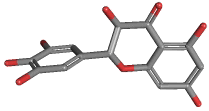|
AMPELOPSIN |
| Synonyms. Ampelopsin; (+)-Ampelopsin; (+)-Dihydromyricetin; (2R,3R)-3,5,7,3',4',5'-Hexahydroxyflavanone; (2R-trans)-2,3-Dihydro-3,5,7-trihydroxy-2-(3,4,5-trihydroxyphenyl)-4H-1-benzopyran-4-one; 3,3',4',5,5',7-Hexahydroxy-2,3-dihydroflavanonol; Ampeloptin; Dihydromyricetin; 3,3',4',5,5',7-Hexahydroxyflavanone; (2R,3R)-3,5,7-Trihydroxy-2-(3,4,5-trihydroxyphenyl)-2,3-dihydrochromen-4-one; 3,3',4',5,5',7-Hexahydroxy-2,3-dihydroflavanonol; |
|
|
| PRODUCT IDENTIFICATION | |
|
CAS RN |
27200-12-0 |
|
EINECS RN |
|
|
FORMULA |
C15H12O8 |
|
MOLE WEIGHT |
320.25 |
|
H.S CODE |
2932.99.6100 |
|
SMILES |
[C@H]1([C@H](C(=O)c2c(O1)cc(cc2O)O)O)c1cc(c(c(c1)O)O)O |
|
CLASSIFICATION |
Phytochemical, Hepatoprotective agent, Antioxidant, Cytoprotectant, Flavanonol, Pyrogallol, Resorcinol |
|
EXTRA NOTES |
Biochem/physiol Actions:Dihydromyricetin (Ampelopsin) is a flavanonol with antioxidant and anti-cancer activity, found to have anti-alcohol intoxication effects. Its anti-alcohol effects appear to be by its actions as a positive modulator of GABA-A receptors at the benzodiazepine site. (sigmaaldrich) |
|
|
| PHYSICAL AND CHEMICAL PROPERTIES | |
|
PHYSICAL STATE. |
white to beige powder |
|
MELTING POINT |
2 ~ C |
|
BOILING POINT |
2 ~ C |
|
DENSITY |
|
|
SOLUBILITY IN WATER |
g/l |
| SOLVENT SOLUBILITY |
|
|
VAPOR DENSITY |
|
|
log P(octanol-water) |
0.003 |
|
VAPOR PRESSURE |
|
|
AUTOIGNITION TEMP |
|
| pK |
|
|
REFRACTIVE INDEX |
|
|
FLASH POINT |
|
|
|
| STABILITY AND REACTIVITY | |
| STABILITY | Stable under normal conditions. |
|
INCOMPATIBLE MATERIALS |
Strong oxidizing agents |
| POLYMERIZATION |
Has not been reported |
|
NFPA RATINGS |
Health: 1, Flammability: 0, Reactivity: 0 |
|
|
| EXTERNAL LINKS & GENERAL DESCRIPTION |
|
USA.gov - Ampelopsin Wikipedia Linking - Ampelopsin Google Scholar Search - Ampelopsin U.S. National Library of Medicine - Ampelopsin PubChem Compound Summary - Ampelopsin KEGG (Kyoto Encyclopedia of Genes and Genomes) - Ampelopsin http://www.ebi.ac.uk/chebi/ - Ampelopsin http://www.ncbi.nlm.nih.gov/ - Ampelopsin |
|
|
| SALES SPECIFICATION | |
|
APPEARANCE |
white to beige powder |
|
ASSAY |
98% min |
|
HEAVY METALS |
10ppm max |
|
|
| TRANSPORT & REGULATORY INFORMATION | |
|
UN NO. |
|
| HAZARD CLASS |
|
| PACKING GROUP | |
|
|
| SAFETY INFORMATION | |
|
HAZARD OVERVIEW |
GHS (Globally Harmonised System) Classification: Not a dangerous substance. Potential Health Effects: Eyes - May cause eye irritation. Skin - May be harmful if absorbed through skin May cause skin irritation. Inhalation - May be harmful if inhaled. May cause respiratory tract irritation. Ingestion - May be harmful if swallowed. |
| HAZARD CODES |
|
|
RISK PHRASES |
|
|
SAFETY PHRASES |
|
|
|
| PACKING |
|
Preserved in light-resistant and well-closed bottles |
|
|
